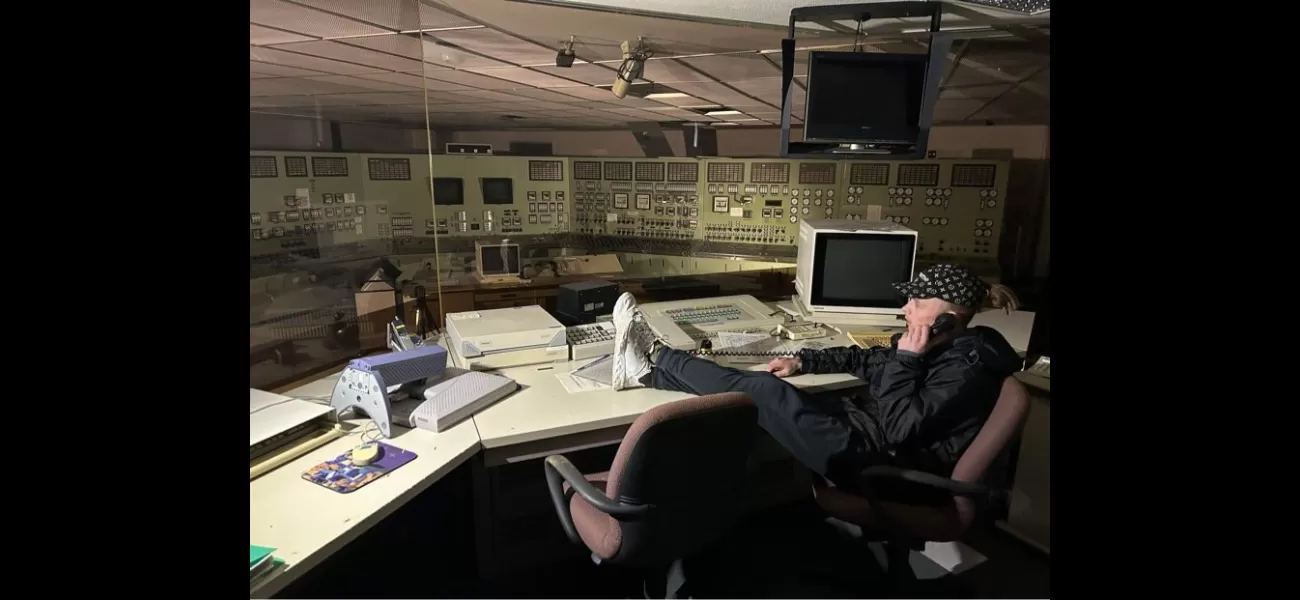Take a look inside Fukushima's abandoned nuclear control room, left untouched since the disaster.
In 2011, an earthquake and tsunami caused a nuclear problem at Fukushima Daiichi nuclear plant.
April 24th 2024.

Next up, we have an extraordinary story of a daring urban explorer who took on the challenge of sneaking into an abandoned nuclear control room in the restricted 'red zone' of Japan. Lukka Ventures, a 27-year-old from the UK, has been exploring abandoned buildings for the past four years, but this time, he set his sights on the town of Ōkuma in Japan. What sparked his interest? Well, it was a documentary on the infamous Fukushima nuclear disaster that struck in 2011.
For those who are unfamiliar, the 'red zone' refers to the area surrounding the Fukushima Daiichi nuclear power plant that was closed off due to concerns over radiation exposure. On March 11, 2011, a powerful earthquake and tsunami rocked Japan and caused a catastrophic nuclear incident at the plant. Three of the six reactors were severely damaged, releasing dangerous levels of hydrogen and radioactive materials into the environment. This forced residents within a 30 km radius to evacuate their homes.
Despite the potential dangers, Lukka was determined to explore the abandoned buildings in the red zone, which included hospitals, malls, and apartments. He was amazed by what he found - these buildings were like a time capsule, untouched since the disaster. Lukka shared, "It was a very surreal experience. Everything had been left as it was on the day of the disaster, with calendars still hanging on the walls and vending machines and walkways slowly being reclaimed by nature."
During his four-day expedition, Lukka carried a Geiger counter to ensure he was not exposing himself to harmful levels of radiation. He and his team had to sneak through rivers and fences to access these forbidden areas. "We had to be really careful of how radiated some of the areas were," Lukka mentioned. "But it was all worth it. The entire experience was surreal, walking through shopping centers with food still on the shelves and every building we entered had a strange, eerie feeling to it."
One of the most interesting discoveries Lukka made was a nuclear bunker in what he believes was a training center. "We entered a big glass building which had a model of the reactor in the lobby. It was a chilling reminder of how close we were to the power plant that exploded," he shared. "We even stumbled upon rooms with nuclear controllers, which was a surreal and somewhat unsettling experience."
However, not all of Lukka's findings were so fascinating. He also came across abandoned homes and personal belongings, which he said "got him upset." Lukka admitted that he is not one to easily get emotional, but the sight of these abandoned homes and personal items left behind by the residents who were forced to flee was a poignant reminder of the tragedy that occurred.
But what about the current state of the Fukushima plant? Is it still radioactive? According to nuclear physicist Dr. Ferenc Dalnoki-Veress, the Fukushima disaster was the most serious incident since the Chernobyl disaster. The damaged reactors are still hot, and there is a significant amount of melted nuclear fuel and debris that require constant cooling. Additionally, rainwater and groundwater that falls on the affected area are also radioactive, causing concerns over the treatment and release of millions of tons of water into the ocean.
The nuclear disaster not only had a devastating impact on the environment but also forced over 160,000 people to flee their homes. And despite efforts to decontaminate the affected areas, it is estimated that the red zone will be uninhabitable for at least 100 years, a relatively short period compared to the estimated 20,000 years it will take for Chernobyl to be habitable again.
However, there is a glimmer of hope as some areas near the exclusion zone have reopened, and people have started to return to their homes. The main Futaba train station, which was closed off for years, has reopened, reconnecting it with the rest of the region. But the unrestricted access to the red zone is still prohibited, with only a one-square-mile area near the train station being accessible.
Despite the human tragedy and the devastation caused by the disaster, nature seems to be thriving in these abandoned areas. Monkeys and other wildlife have been spotted in the red zone, showing that even in the face of disaster, life finds a way. Similar to the Chernobyl disaster, wildlife has reclaimed the ruins of the abandoned town of Pripyat.
Lukka's experience in the Fukushima red zone will stay with him forever, and he hopes that his videos and photos will help shed light on the aftermath of the disaster and the current state of the affected areas. He ended by saying, "It was an unforgettable experience, and it's something that I will always carry with me. It's a stark reminder of the fragility of life and the devastating consequences of a natural disaster."
For those who are unfamiliar, the 'red zone' refers to the area surrounding the Fukushima Daiichi nuclear power plant that was closed off due to concerns over radiation exposure. On March 11, 2011, a powerful earthquake and tsunami rocked Japan and caused a catastrophic nuclear incident at the plant. Three of the six reactors were severely damaged, releasing dangerous levels of hydrogen and radioactive materials into the environment. This forced residents within a 30 km radius to evacuate their homes.
Despite the potential dangers, Lukka was determined to explore the abandoned buildings in the red zone, which included hospitals, malls, and apartments. He was amazed by what he found - these buildings were like a time capsule, untouched since the disaster. Lukka shared, "It was a very surreal experience. Everything had been left as it was on the day of the disaster, with calendars still hanging on the walls and vending machines and walkways slowly being reclaimed by nature."
During his four-day expedition, Lukka carried a Geiger counter to ensure he was not exposing himself to harmful levels of radiation. He and his team had to sneak through rivers and fences to access these forbidden areas. "We had to be really careful of how radiated some of the areas were," Lukka mentioned. "But it was all worth it. The entire experience was surreal, walking through shopping centers with food still on the shelves and every building we entered had a strange, eerie feeling to it."
One of the most interesting discoveries Lukka made was a nuclear bunker in what he believes was a training center. "We entered a big glass building which had a model of the reactor in the lobby. It was a chilling reminder of how close we were to the power plant that exploded," he shared. "We even stumbled upon rooms with nuclear controllers, which was a surreal and somewhat unsettling experience."
However, not all of Lukka's findings were so fascinating. He also came across abandoned homes and personal belongings, which he said "got him upset." Lukka admitted that he is not one to easily get emotional, but the sight of these abandoned homes and personal items left behind by the residents who were forced to flee was a poignant reminder of the tragedy that occurred.
But what about the current state of the Fukushima plant? Is it still radioactive? According to nuclear physicist Dr. Ferenc Dalnoki-Veress, the Fukushima disaster was the most serious incident since the Chernobyl disaster. The damaged reactors are still hot, and there is a significant amount of melted nuclear fuel and debris that require constant cooling. Additionally, rainwater and groundwater that falls on the affected area are also radioactive, causing concerns over the treatment and release of millions of tons of water into the ocean.
The nuclear disaster not only had a devastating impact on the environment but also forced over 160,000 people to flee their homes. And despite efforts to decontaminate the affected areas, it is estimated that the red zone will be uninhabitable for at least 100 years, a relatively short period compared to the estimated 20,000 years it will take for Chernobyl to be habitable again.
However, there is a glimmer of hope as some areas near the exclusion zone have reopened, and people have started to return to their homes. The main Futaba train station, which was closed off for years, has reopened, reconnecting it with the rest of the region. But the unrestricted access to the red zone is still prohibited, with only a one-square-mile area near the train station being accessible.
Despite the human tragedy and the devastation caused by the disaster, nature seems to be thriving in these abandoned areas. Monkeys and other wildlife have been spotted in the red zone, showing that even in the face of disaster, life finds a way. Similar to the Chernobyl disaster, wildlife has reclaimed the ruins of the abandoned town of Pripyat.
Lukka's experience in the Fukushima red zone will stay with him forever, and he hopes that his videos and photos will help shed light on the aftermath of the disaster and the current state of the affected areas. He ended by saying, "It was an unforgettable experience, and it's something that I will always carry with me. It's a stark reminder of the fragility of life and the devastating consequences of a natural disaster."
[This article has been trending online recently and has been generated with AI. Your feed is customized.]
[Generative AI is experimental.]
0
0
Submit Comment





